This homemade baby soap bar is gentle and safe for sensitive baby skin. Made with coconut oil, mango butter, and jojoba oil, this cold-process baby soap nourishes and moisturizes the baby’s skin.
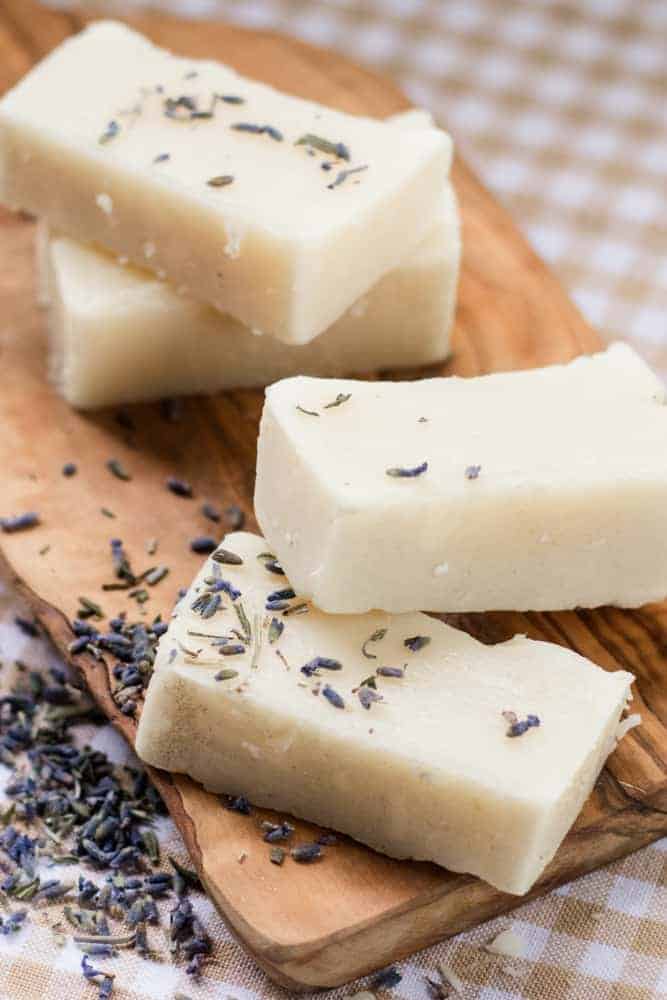
Making soap is actually quite simple and can be made for a relatively low cost. My soap-making days started with melt and pour bases solely due to the fact I was very nervous about the lye. But as with most things, after I made it once, I realized it was much easier than I thought and could be done safely.
This baby soap recipe is perfect for baby’s skin; it is gentle, cleansing and leaves the skin soft and smooth. This soap is made with all-natural ingredients and scented with pure lavender essential oil.
How to Make the Best Homemade Baby Soap Bar?
In order to make cold-process soap bars, you will need lye, a liquid and either a fat or oil. The oil, when mixed with the lye, is what allows for the saponification process making the lye safe. Choosing different oils or fats, for example, allows you to make different styles of soap, such as a moisturizing soap bar for dry skin, while others will make the perfect bar for oily skin.
For this baby soap recipe, I am choosing gentle and moisturizing ingredients that are perfect for sensitive skin.
Baby Soap Ingredients
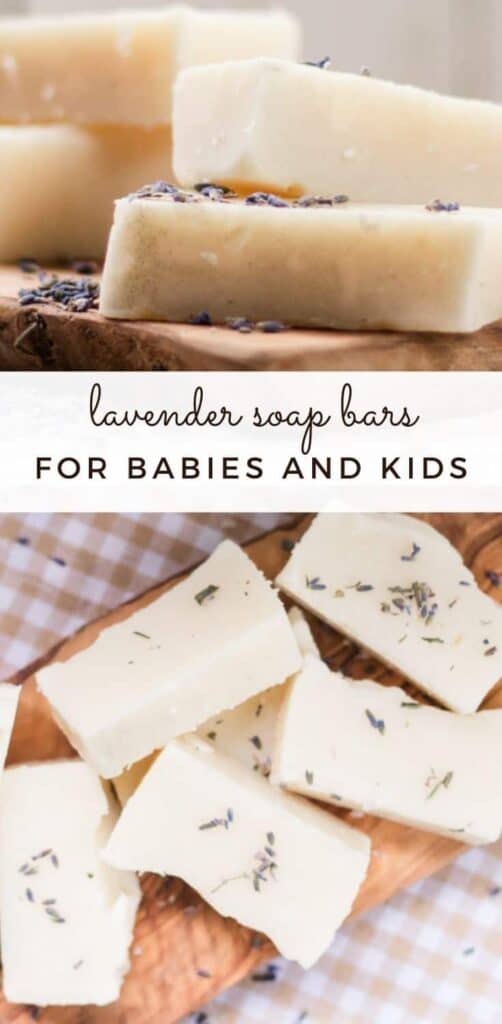
This post contains affiliate links, which means I make a small commission at no extra cost to you. Get my full disclosure HERE.
- Coconut oil
- Mango butter
- Jojoba oil
- Lavender essential oil (optional)
- Lye
- Water
Coconut Oil
Coconut oil is the perfect oil to add to baby soap because it is very gentle, full of nourishing vitamins and can help with common childhood rashes. It is often found in soaps, creams, and hair care products.
Benefits of Coconut Oil for Skin
- Hydrating for dry skin
- Good source of antioxidants
- Brighten and soften skin
- Anti-inflammatory properties to help reduce skin irritations
- Anti-bacterial properties to cleanse wounds
- Anti-fungal properties to help with yeast and fungus
- Soothe and smooth skin
Mango Butter
Mango butter comes from the pit of the mango. It is very similar to cocoa butter and shea butter in that it moisturizes the skin without leaving it feeling greasy. In addition, Mango butter is high in vitamins A and E, which encourages the skin to produce new healthy skin cells.
Benefits of Mango Butter for Skin
- Highly moisturizing
- Nourishing
- Natural source of vitamins A, C, and E
- Smooths skin
- Anti-inflammatory
- Soothing for dry, cracked skin and eczema
- Contains essential fatty acids and antioxidants
Jojoba Oil
Jojoba oil comes from the wax that is produced from the seeds of the jojoba shrub. It is a carrier oil that is oftentimes used with essential oils and in natural skincare. Jojoba oil is nourishing, cleansing, purifying, and moisturizing.
Benefits of Jojoba Oil for Skin
- Hypoallergenic
- Antibacterial
- Good source of antioxidants
- Cleansing for wounds
- Helps with eczema
- Rich in vitamin E
- Moisturizing
Lavender Essential Oil
Lavender is a very gentle oil. I use it to scent my castile soap bar and it is a great choice for this soap recipe. It is very soothing for the skin and gives off a relaxing aroma.
This lavender soap bar will be a great addition to your bedtime routine as it can help your baby fall asleep quicker and stay asleep longer.
Benefits of Lavender Essential Oil for the Skin
- Gentle and cleansing
- Reduce skin irritations
- Promotes healthy skin
- Reduces scars
- Calming and relaxing aroma
Other Essential Oils You Can Use
- Roman Chamomile
- Frankincense
- Rose
- Jasmine
- Copaiba
What do You Need to Make Cold-Process Soap Bar?

- Soap mold
- Immersion Blender
- Digital scale
- Glass bowl or other heat resistant container
- Gloves
- Eye protection, full covering goggles are best
Natural Baby Soap Recipe
I used a soap calculator to get these exact measurements. If you want to change up the recipe at all, you will need to get new measurements. Having the right proportions is a crucial step in soap making.
Safety Note: When working with lye, be sure to work in a well-ventilated area and wear safety goggles and rubber gloves. If lye gets on the skin or in the eyes, it can be very harmful.
How to Make Soap for Kids
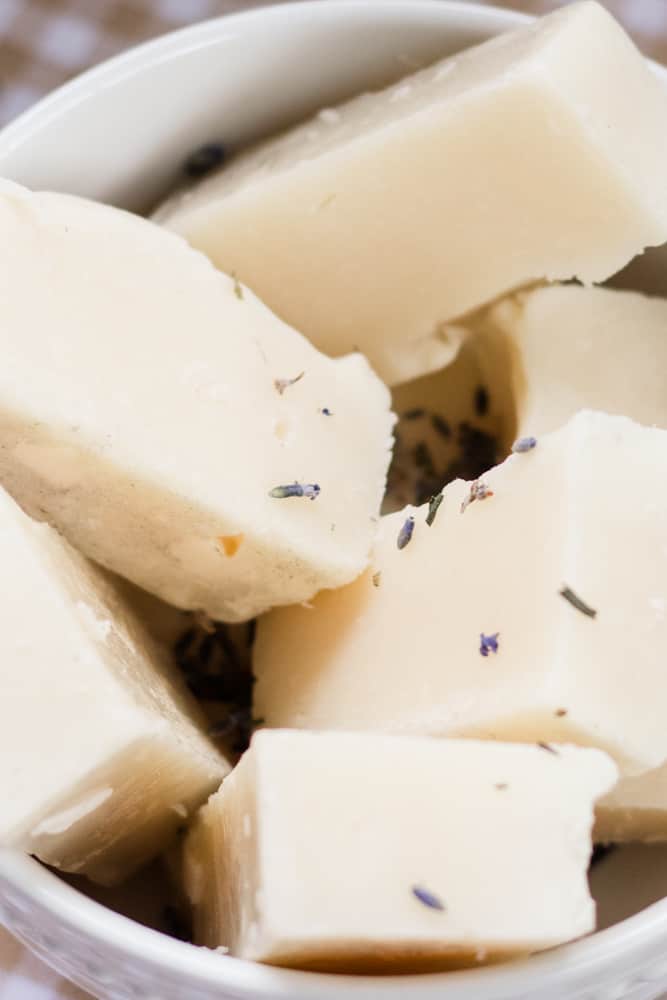
- Using a digital scale, measure out your water and pour it into a heat-resistant glass or thick heat-resistant plastic pitcher.
- Measure out the lye and add it to the water. Stir the lye into the water slowly until it dissolves. Note, the chemical reaction will cause it to heat up quickly.
- Using the digital scale, measure out the coconut oil, mango butter, and jojoba oil. Pour into a medium-size saucepan and melt over medium heat.
- Once the oils and butter are melted, remove it from the heat.
- When the oil cools to 100°F, slowly add the lye and water mixture to the oil, mix with an immersion blender. This will take a couple of minutes. You will know it is the right consistency when the soap from the blender drips and pools up on top of the soap in the saucepan. This is known as the trace.
- Add in the lavender essential oil and mix in with the immersion blender.
- Pour the soap into a soap mold. If using silicone soap molds, no prep is required. Other molds may require parchment paper.
- Allow the soap to harden in the molds for a minimum of 24 hours or up to 3 days.
- Remove the soap from the molds and allow to cure for an additional 3-4 weeks before using.
How to Use Natural Baby Soap
Use the homemade baby soap bar like normal, staying clear of your child’s eyes. This soap bar will work great for both the hair and body. Allow the soap to soak in for a couple of minutes before rinsing off with warm water.
More of my favorite soap bars

Gentle Baby Soap Bar Recipe
Equipment
- Soap mold
- Glass bowl or other heat resistant container
- Gloves
- Eye protection, full covering goggles are best
Ingredients
- 6 ounces coconut oil
- 8 ounces mango butter
- 4 ounces jojoba oil
- 10 drops lavender essential oil
- 2.3 ounces lye
- 5.2 ounces water
Instructions
- Use a digital scale to measure out the water and add it to a heat-resistant container.
- Slowly pour the lye into the water. Stir the lye in water slowly until it dissolves. Note, the chemical reaction will cause it to heat up quickly. Set aside.
- Melt coconut oil, mango butter, and jojoba oil in a medium-size saucepan over medium heat.
- Once the butter and oils are melted, remove from heat.
- When the oils cool to 100°F, add the lye water in and mix with an immersion blender. This will take a couple of minutes. You will know it is the right consistency when the soap from the blender drips and pools up on top of the soap in the saucepan. This is known as the trace.
- Add in the lavender essential oil, mix in with the immersion blender.
- Pour the soap directly into the silicone soap molds. If using another type of mold, it may require parchment paper.
- Allow the soap to harden for at least 24 hours or up to 3 days.
Remove the soap from the molds and allow bars to cure for 3-4 weeks before using.
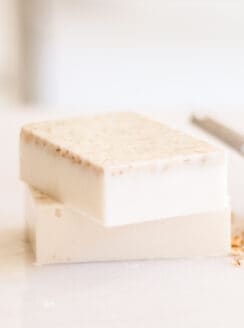
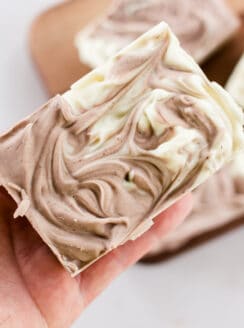
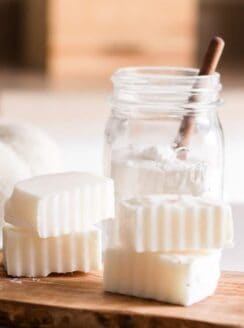
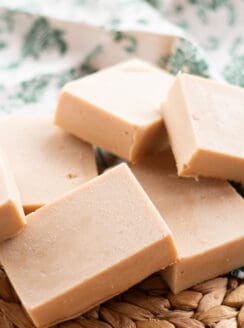
Natalie says
Hi, can this be made with a melt and pour soap base so i dont have to use Lye, and it will still be safe for sensitive baby skin?
brianna h says
Hi! Can I just use a melt and pour base for this so I dont have to use the lye?
Laura says
Yes, you can! I have several melt-and-pour recipes on my blog you can check out.
Pinky says
Hi Laura
After curing soap , essential oil smell went off
Is any other option
Laura says
Consider adding more essential oils. I dilute them quite a bit to prevent any irritation.
Jazmin Vickers says
Hi, if I was using melt and pour. How much would I use instead of lye and water?
Thankyou
Farah Louis says
Hi Laura, thx for sharing,I will definitely try this out, do you do tear free. Thx again.
Tricia says
Hi first time using your recipe and I must say once you follow the instructions soap came out beautiful.I’m new to soap making and the this is a great help. Thanks LAura
Laura says
I am so glad! Thanks for sharing!
Emily says
Hi Laura ! Can I divide the ingredients per two ? I don’t want to make too much of it, and the video shows that the recipe’s for a huge pile of soap bars. Also, do you think it is possible to use Shea butter instead of mango butter 🧼 ? I’d like to keep my product’s comedogenic rating close to 0…
Thanks for everything you’re doing. I am a newbie in aromatherapy, and because of people like you, I feel confident when diying ! 🙂
Laura says
Yes, you can half the recipe. Also, to change out ingredients you can use a soap calculater to get the correct measurements.
Stacey T. says
I’m super excited about this recipe! My niece is having a baby shower pretty soon and I will have plenty of time to get this done for her. They all know me as the hippie aunt and have been getting natural goodies for Christmas for several years now. I’m hoping you might also have of know of a recipe for baby powder. The ingredients seem to vary so much and I trust your recipes. Thank you for sharing your wonderful knowledge with us.
Laura says
Aww, that is a great idea! I have made this for all my babies and I love it!
Alison says
I love this! I’m having a grand baby soon and would love to make some for her. Would this be considered tear free?
Laura says
I have not fully tested this, so I can’t say for sure. We use it on our kids and they have never complained but I do not try to get it in their eyes.
Sibongile says
Hi may God bless you for sharing with us your information about soap recipes I would like to know if you have recipes for lotion making and what preservatives do I need to make lotion
Deborah Billman says
Hi,
Can you list a recipe for a nice soft bar of soap like the baby bar except without lye? is there a way to make a bar softer without using lye? the bar you made looked so nice and gentle, loved it.
thank you
Laura says
No, you have to have lye to make soap.
Kathleen-Patricia: says
Hi Laura,
Thank you so much for sharing your beautiful natural recipes with us!
I always look forward to seeing what new product you’ve created and trying out your recipes as they are all fabulous and great to use!
Thanks again Laura, you and your recipes are appreciated ;-D
God Bless you and your family xox
Laura says
Thank you so much!